Contemporary Church History Quarterly
Volume 23, Number 3 (September 2017)
Luther’s Evil Writings
The reformer was not only anti-Jewish, but also antisemitic. So he was understood in the Nazi era, too.
By Manfred Gailus, Technical University of Berlin; translated by Kyle Jantzen, Ambrose University
The original article was published in German as “Luthers böse Schriften” in Der Tagesspiegel, 18 July 2017, and is available at http://www.tagesspiegel.de/wissen/hass-auf-juden-luthers-boese-schriften/20071254.html. It is produced here in translation by permission of the author and newspaper.
Martin Luther’s late “Jewish writings” are no longer as unknown as they were for a long time—and the horror over the sharp anti-Jewish tone of the reformer is great everywhere. Heinrich Bedford-Strohm, Chair of the EKD, has repeatedly confessed in interviews that he is ashamed of such texts by the principal founder of the Protestant churches in Germany.
Was Martin Luther an antisemite? And what would that mean for the Lutheran Churches as public-law institutions? For the many churches named after him? For a city which proudly bears the name “Lutherstadt Wittenberg”? For the many schools and streets that bear his name? Or was he perhaps not antisemitic, but “merely” an anti-Judaist motivated by Christian theology?
In the writing of church history, things have been seen this way for a long time. Certainly, most would concede that Luther’s “Jewish writings” are bad, but would add that his case is not one of genuine antisemitism, but “merely” one of theologically based (though also harsh) anti-Judaism. It is often added, however, that in his youth he wrote in a friendly manner, and that later he had grown old, was suffering from physical affliction and depression, and had long been disappointed by the stubborn unteachability of his Jewish contemporaries.
He was “only” anti-Jewish, reads the official view of the Church
Margot Käßmann, commissioned by the EKD as a Reformation and Luther ambassador for the 2017 commemorative year, is not always to be envied for her job, especially when it comes to the topic “Luther and the Jews.” As far as can be seen, the Luther ambassador (like Bedford-Strohm) maintains that Luther was “anti-Jewish” in his bad omissions about the Jews, and thus not antisemitic.
It’s easy to understand. After Hitler and the Holocaust, how today can anyone—no matter their undisputed achievements and merits—be advertised as an antisemite? At their Synod in Bremen (November 2015) the EKD approved a statement “Martin Luther and the Jews – A Necessary Reminder on the Occasion of the Reformation Anniversary.” The reformers, it says, stood in a tradition of anti-Jewish patterns of thought, whose roots reached back to the beginnings of the Church. With regard to Luther’s utterances, “hatred of Jews,” “resentments,” or “invective against Jews” is the language used—the word “antisemitism” is carefully avoided. Here, as elsewhere, the view is that antisemitism exists only in cases of racial antisemitism, which had only existed since the second half of the nineteenth century. So, it is said, we cannot talk about antisemitism when it comes to Luther.
Luther was taken up with the expulsion of the Jews
Thomas Kaufmann, the Göttingen church historian who stands beyond reproach as an expert in the Reformation period, came to the conclusion in his study Luthers Juden (2014) that Luther’s Jew hatred had included motifs that went beyond traditional Christian anti-Judaism. In addition to Luther’s central theological anti-Judaism, Kaufmann also attributes “premodern antisemitism” to the reformer. Luther ‘s recommendations to sixteenth-century authorities and church leaders, which he described as “severe mercy,” were notorious: destruction of synagogues, homes, and writings; confiscation of money and property; forced labor; prohibition of Jewish worship services; and, as the ultima ratio, the expulsion of Jewish communities from city and country. With relation to Luther’s evil writings, the church historian Kaufmann speaks of “a literary final solution of the Jewish question.”
It is well known that by 1933 a powerful antisemitism had spread among Protestant theologians. Did they get it from Martin Luther? Pastor Siegfried Nobiling, who held a position in the “Zum Guten Hirten” (“Good Shepherd”) parish (Berlin-Friedenau) since 1928, professed in a 1932 statement on National Socialism: “In conclusion, I can confess quite sincerely that National Socialism was for me destiny and experience.”
“The interests of the race,” he said, “are always valid only to the extent that they are useful to the nation as a whole. We see in Judaism the spiritual-biological poisoning of our race.”
Already in 1932, Nobiling joined the “Faith Movement of the German Christians” (DC). There he met numerous like-minded colleagues.
For the theologian-generation of 1933, the Reformations of the sixteenth century and with them Luther’s image of the Jews lay far in the background. There were, first and foremost, other impulses directly and personally experienced, which were closer to them and which determined their attitudes toward Jews. Paramount for the anti-Jewish conditioning of this generation were, for example: the historian Heinrich von Treitschke, the Berlin court preacher Adolf Stoecker, the influential theology professor Reinhold Seeberg, then also the antisemitic and Christian “Association of German Student Fraternities” (VVDSt); and the unloved Weimar democracy, which was maligned as the “godless republic.”
In the Nazi era, there was a remarkable Luther revival
The sense of religious excitement of 1933, marked by the antisemitic “German Christians,” also included a remarkable Luther revival: the reformer as German national hero, as the prototype of the quintessential German man and fighter. Not infrequently, historical lines of tradition were drawn from Luther to Hitler—by Protestants themselves, and with pride. In the “Advent” parish (Prenzlauer Berg), “German Christian” member Haertel spoke on December 12, 1933, about “Luther and the Jews.” It must be the task of the “German Christians” to fully re-establish Luther’s clear position in the “Jewish question,” which Hitler had taught anew.
In the Spandau “Luther” parish, in parallel with the passing of the “Nuremberg Laws,” the parish church council decided in September 1935 to undertake the immediate free distribution of one thousand copies of “Luther and the Jews” as well as the procurement of display cases for Streicher’s Der Stürmer. In March 1937, Johannes Schleuning, a superintendent in Berlin East, referred in particular to Martin Luther and Adolf Stoecker as Christian champions against Judaism, in an article entitled “Judaism and Christianity.” He praised the most recent special issue of Der Stürmer on the “Jewish question” and emphasized that Christ had been an “Aryan,” a Nordic hero, as described by Houston Stewart Chamberlain.
In contrast to the “Nuremberg Laws,” which were widely endorsed in the “German Christian” press, silence prevailed throughout the Protestant milieu after the Kristallnacht pogroms of 1938. Explicit approval of the excesses was rare, but it did occur. On November 20, 1938, the “German Christian” theologian Immanuel Schairer wrote a commentary on the events, expressly referring to Luther’s “On the Jews and their Lies.” Immediately after the pogroms, the Thuringian Protestant bishop, Martin Sasse, printed extracts from Luther’s “Jewish writings” and sent them to Thuringian pastors. The intense Protestant antisemitism of the Hitler period fed on many sources—not only religious or theological—and mainly on those which were closer to the protagonists historically and biographically than Luther’s “Jewish writings.” Thus, on the one hand, these writings were not needed at all to generate the massive antisemitic confessions in the churches of the Hitler period. Since 1933, however, everywhere Luther’s “Jewish writings” were dug out and disseminated in the media, they reaffirmed the already-existing Protestant antisemitism and gave it additional legitimation.
Even before 1933, Luther’s “Judenschriften” had to be regarded as a serious derailment
Even before the year 1933, Luther’s “Jewish writings” had to be regarded as a serious derailment in the eyes of unbiased readers. After Hitler and the Holocaust, these writings stand in a changed historical context, which once again places the texts in a different light and makes Luther’s verbal derailments even more serious.
The current 2017 memorial year is the first Lutheran and Reformation commemoration ever to make the existence and explosiveness of the “Jewish writings” known to a broader public. This is to be welcomed as a historical clarification. For today’s Protestant churches, however, it is not easy to deal with this problematic heritage. In the long run, euphemistic assessments such as “anti-Judaism” or the discordant metaphor of the regrettable “shadows” of the great theologian will not suffice. One also wonders what the Protestant “learning history,” much invoked during the 2017 commemorative year, is supposed to mean, considering the churches’ performance (after 400 years of learning time) during the “Third Reich.”
Luther the confession-founder will not be taken away from anxious church contemporaries. The reformer is historically significant, and that will continue into the future. Still, the current image of Luther will have to keep changing. His status as a monumental figure will diminish, while the Luther-dilemma associated with his antisemitism will grow.
The author is Professor of Modern History at the Centre for Antisemitism Research at the Technical University of Berlin.

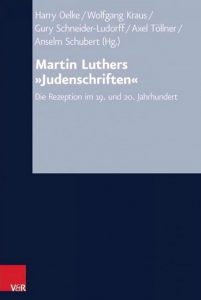 The volume is a product of the conference “The Reception of Luther’s ‘Judenschriften’ in the 19th and 20th Centuries,” which was held at Erlangen University in October 2014. The contributors, who number more than a dozen, represent fields that include Protestant church history, Protestant systematic theology, religion, Jewish studies, and Catholic theology. As the book’s title suggests, the collection of essays covers a broad chronological range; the thematic terrain is wide as well. This breadth is one of the volume’s greatest strengths. The essays addressing nineteenth-century reception of Luther’s Judenschriften are especially welcome, as are Christian Wiese’s insightful treatment of Jewish and antisemitic Luther lectures in the Kaiserreich and the Weimar Republic and Volker Leppin’s analysis of Luther’s Judenschriften in the light of the editions prior to 1933. Yet, there are some problematic elements as well, including some of the conclusions reached about Protestant reception of the Judenschriften during the Third Reich. These will be addressed (together with the volume’s strengths) after a summary of the contents.
The volume is a product of the conference “The Reception of Luther’s ‘Judenschriften’ in the 19th and 20th Centuries,” which was held at Erlangen University in October 2014. The contributors, who number more than a dozen, represent fields that include Protestant church history, Protestant systematic theology, religion, Jewish studies, and Catholic theology. As the book’s title suggests, the collection of essays covers a broad chronological range; the thematic terrain is wide as well. This breadth is one of the volume’s greatest strengths. The essays addressing nineteenth-century reception of Luther’s Judenschriften are especially welcome, as are Christian Wiese’s insightful treatment of Jewish and antisemitic Luther lectures in the Kaiserreich and the Weimar Republic and Volker Leppin’s analysis of Luther’s Judenschriften in the light of the editions prior to 1933. Yet, there are some problematic elements as well, including some of the conclusions reached about Protestant reception of the Judenschriften during the Third Reich. These will be addressed (together with the volume’s strengths) after a summary of the contents.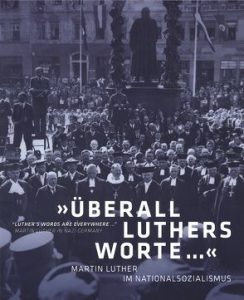 The first part of the catalog impressively illustrates the instrumentalization of Luther as the “German faith hero” in the first two years of the Third Reich by using photographs and covers of contemporary publications. Several Protestant representatives drew an additional historical and theological continuity line from Luther to Hitler. Publications and celebrations such as the 450th anniversary of the reformer in 1933and the celebration of the 400th anniversary of the Bible translation in 1934 illustrate the reference to Luther at this time. Likewise, many new church buildings were named after the reformer, the most well-known example being the Martin Luther Memorial Church in Berlin-Mariendorf, consecrated in 1935. On the theological level, in the early years of the Nazi regime, Luther’s doctrine of the two kingdoms was the center of church-political debates concerning the relationship between the church and the state. But this was increasingly changing in the mid-1930s. As a result of the exclusion of the Jews forced by the National Socialists, Luther’s antisemitic “Jewish writings” were increasingly placed at the center of the reformer’s reception. These writings often served as justification for the persecution of the Jews from a theological point of view. It is somewhat surprising that the section on the state-church relationship is mainly related to the view of the National Socialists, Bonhoeffer, Niemöller, and other representatives of the Confessing Church. The German Christians with their theological line of continuity of Jesus-Luther-Hitler are hardly mentioned in this section.
The first part of the catalog impressively illustrates the instrumentalization of Luther as the “German faith hero” in the first two years of the Third Reich by using photographs and covers of contemporary publications. Several Protestant representatives drew an additional historical and theological continuity line from Luther to Hitler. Publications and celebrations such as the 450th anniversary of the reformer in 1933and the celebration of the 400th anniversary of the Bible translation in 1934 illustrate the reference to Luther at this time. Likewise, many new church buildings were named after the reformer, the most well-known example being the Martin Luther Memorial Church in Berlin-Mariendorf, consecrated in 1935. On the theological level, in the early years of the Nazi regime, Luther’s doctrine of the two kingdoms was the center of church-political debates concerning the relationship between the church and the state. But this was increasingly changing in the mid-1930s. As a result of the exclusion of the Jews forced by the National Socialists, Luther’s antisemitic “Jewish writings” were increasingly placed at the center of the reformer’s reception. These writings often served as justification for the persecution of the Jews from a theological point of view. It is somewhat surprising that the section on the state-church relationship is mainly related to the view of the National Socialists, Bonhoeffer, Niemöller, and other representatives of the Confessing Church. The German Christians with their theological line of continuity of Jesus-Luther-Hitler are hardly mentioned in this section.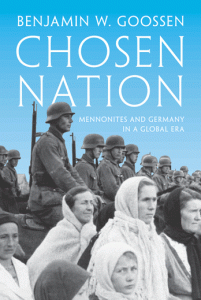 Chosen Nation argues that “Mennonitism should not be understood as a single group—or even as an amalgamation of many smaller groups.” Rather, the book seeks to uncover “what the idea of Mennonitism has meant for various observers” and “how and why interpretations have developed over time” (7). Goossen’s transnational history argues that Mennonites appropriated German nationalism when it was in their interest to do so and suppressed or abandoned it when it became problematic. Into the 1800s, Mennonites had commonly understood themselves to be a global confessional community. As the century wore on, however, they began to portray themselves as “archetypical Germans” (13). As Emil Händiges, the long-time chairman of the progressive Union of Mennonite Congregations in the German Empire (established in 1886), put it, “Do not almost all Mennonites … wherever they may live—in Russia, in Switzerland, in Alsace-Lorraine, Galicia, Pomerania, in the United States and Canada, in Mexico and Paraguay, yes even in Asiatic Siberia and Turkestan—speak the same German mother tongue? Are not the Mennonites, wherever they go, also the pioneers of German language, customs, and culture?” (13). Whether the Mennonites in these far-flung locales—or even in conservative congregations in the new German Empire—understood themselves as the promoters of German culture was another matter entirely.
Chosen Nation argues that “Mennonitism should not be understood as a single group—or even as an amalgamation of many smaller groups.” Rather, the book seeks to uncover “what the idea of Mennonitism has meant for various observers” and “how and why interpretations have developed over time” (7). Goossen’s transnational history argues that Mennonites appropriated German nationalism when it was in their interest to do so and suppressed or abandoned it when it became problematic. Into the 1800s, Mennonites had commonly understood themselves to be a global confessional community. As the century wore on, however, they began to portray themselves as “archetypical Germans” (13). As Emil Händiges, the long-time chairman of the progressive Union of Mennonite Congregations in the German Empire (established in 1886), put it, “Do not almost all Mennonites … wherever they may live—in Russia, in Switzerland, in Alsace-Lorraine, Galicia, Pomerania, in the United States and Canada, in Mexico and Paraguay, yes even in Asiatic Siberia and Turkestan—speak the same German mother tongue? Are not the Mennonites, wherever they go, also the pioneers of German language, customs, and culture?” (13). Whether the Mennonites in these far-flung locales—or even in conservative congregations in the new German Empire—understood themselves as the promoters of German culture was another matter entirely.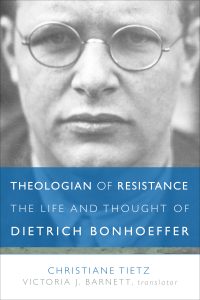 Whereas a new biography of Martin Niemöller is long overdue, one might ask: do we need another on Bonhoeffer?
Whereas a new biography of Martin Niemöller is long overdue, one might ask: do we need another on Bonhoeffer? 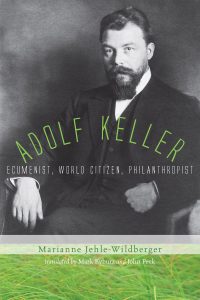 Marianne Jehle-Wildberger’s biography of the Swiss Reformed pastor Adolf Keller traces the life and times of an ecumenical pioneer. Born in 1872, Adolf Keller served churches in Geneva and Zurich as well as the Protestant congregation in Cairo. During the 1920s he became active in the ecumenical movement and was elected second associate general secretary of the Universal Christian Conference on Life and Work at its founding meeting in 1925. In 1922 he founded Inter-Church Aid, an ecumenical relief agency that focused on rebuilding and assisting Protestant communities across Europe in the wake of the First World War. His work was concentrated on the plight of Protestant and Orthodox minorities in Eastern Europe, and the chapter on the interwar situation of these communities in Poland, the Baltic states, Austria, and elsewhere is fascinating. The after-effects of the war included widespread poverty, resurgent nationalisms, shifting church boundaries, and growing political and social instability that posed a vital threat to some of the Protestant minority churches. Keller ambitiously viewed his task as raising international Protestant awareness and “promoting Protestant unification,” and he became a driving force in organizing the different denominational agencies that emerged to assist their partner churches in Europe. He also became a remarkably good fundraiser, raising 1.7 million Swiss francs from U.S. and European churches for his work by 1924.
Marianne Jehle-Wildberger’s biography of the Swiss Reformed pastor Adolf Keller traces the life and times of an ecumenical pioneer. Born in 1872, Adolf Keller served churches in Geneva and Zurich as well as the Protestant congregation in Cairo. During the 1920s he became active in the ecumenical movement and was elected second associate general secretary of the Universal Christian Conference on Life and Work at its founding meeting in 1925. In 1922 he founded Inter-Church Aid, an ecumenical relief agency that focused on rebuilding and assisting Protestant communities across Europe in the wake of the First World War. His work was concentrated on the plight of Protestant and Orthodox minorities in Eastern Europe, and the chapter on the interwar situation of these communities in Poland, the Baltic states, Austria, and elsewhere is fascinating. The after-effects of the war included widespread poverty, resurgent nationalisms, shifting church boundaries, and growing political and social instability that posed a vital threat to some of the Protestant minority churches. Keller ambitiously viewed his task as raising international Protestant awareness and “promoting Protestant unification,” and he became a driving force in organizing the different denominational agencies that emerged to assist their partner churches in Europe. He also became a remarkably good fundraiser, raising 1.7 million Swiss francs from U.S. and European churches for his work by 1924. Heinrich Rusterholz’s book on the work of the Swiss Protestant Relief Agency (Hilfswerk) for the Confessing Church covers some of the same territory (and naturally includes additional documentation on Keller’s work), but focuses on the Swiss Reformed circles and their responses to the German Church Struggle and the persecution of the Jews. Paul Vogt, the leader of many of these initiatives, is another under-examined figure in the history. Born in 1900, he began his career in 1929, focusing in his ministry on unemployment and other working class issues. He founded a social ministry center, “Sonneblick,” that became a refugee haven in the mid-1930s. From 1936-43 he was a pastor in a suburb of Zurich. He also began to work closely with Karl Barth, and the two founded the Hilfswerk in 1937 in solidarity with the German Confessing Church; one of their first actions was to organize statements of support for imprisoned Martin Niemoeller. The organization also began to offer seminars in Switzerland for lay and clergy from the Confessing Church.
Heinrich Rusterholz’s book on the work of the Swiss Protestant Relief Agency (Hilfswerk) for the Confessing Church covers some of the same territory (and naturally includes additional documentation on Keller’s work), but focuses on the Swiss Reformed circles and their responses to the German Church Struggle and the persecution of the Jews. Paul Vogt, the leader of many of these initiatives, is another under-examined figure in the history. Born in 1900, he began his career in 1929, focusing in his ministry on unemployment and other working class issues. He founded a social ministry center, “Sonneblick,” that became a refugee haven in the mid-1930s. From 1936-43 he was a pastor in a suburb of Zurich. He also began to work closely with Karl Barth, and the two founded the Hilfswerk in 1937 in solidarity with the German Confessing Church; one of their first actions was to organize statements of support for imprisoned Martin Niemoeller. The organization also began to offer seminars in Switzerland for lay and clergy from the Confessing Church.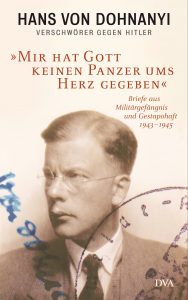 Dohnanyi had been trained as a constitutional lawyer and had held significant posts in the Ministry of Justice. But he had early on become dismayed at the illegal activities and political violence of the Nazi extremists and had in fact drawn up a dossier which documented these misdeeds in full detail.
Dohnanyi had been trained as a constitutional lawyer and had held significant posts in the Ministry of Justice. But he had early on become dismayed at the illegal activities and political violence of the Nazi extremists and had in fact drawn up a dossier which documented these misdeeds in full detail.